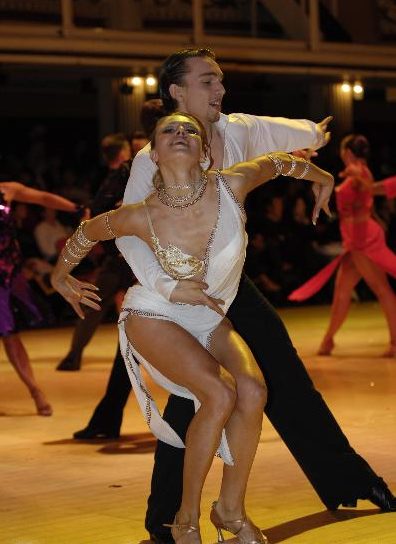
Ballroom
Viennese Waltz:
An Austrian court dance to a ¾ rhythm, dance at balls and elite social occasions around Europe. Its relatively fast pace makes it a challenge for intermediate and an aspiration for most beginner dancers.
Slow (English) Waltz:
A derivative of the Viennese Waltz, this version of the Austrian court dance was slowed down for courts in other European countries, and gradually developed its own form and technique.
Foxtrot:
This dance was first developed by slaves in the United States of America as the mockingly imitated the ‘posh’ walk of their owners during important social occasions. The dance developed as the ‘Cake Walk’ and ‘Harlem Shuffle’ only to be re-introduced to elite white society as a novelty animal dance later on. Throughout the 20th century it was one of the most sought after social dances in Western world.
Quickstep:
A derivative of the Foxtrot this faster paced dance, combines elements of swing and Charlston in its energetic delivery which became popular in early twentieth century and still survives today in its modern ballroom form.
Tango:
This was the most controversial of the ballroom dances today. Developed in the brothels of Buenos Aires by migrant workers, it slowly made its way to Paris where it got popularized among the higher classes eventually migrating back to Argentina to become a sough after dance among the country’s elite.
Latin
Cha Cha Cha:
This Cuban dance was formed when musicians began to play a syncopation in their Mambo beats. The dancers started to mimic that syncopation in their dance and made a shuffling noise on the ground which formed the basis of the name of the dance. Cha Cha Cha usually portrays playfulness, and flirtatious movement.
Rumba:
This dance was formed out of the Sol, which was a traditional Cuban social dance popular in the early 1900s and still danced today in some parts of the country. The ballroom Rumba still retains some elements of Sol such as the changes from slow to faster rhythms and box steps typical of the social dance, however, in many ways Ballroom has developed its own style of movement and relationship to music.
Samba:
Is a ballroom version of the Carnival dance popular in Brazil. Some of the roots of Samba also link back to the religious dances of Brazilian Orixia gods. Traditionally danced in solo or groups this dance was modified in ballroom to fit the couple framework and was stripped of its spiritual affiliations.
Paso Doble:
In ballroom, this is a combination of the Spanish social dance of the same name, Flamenco, and an imitation of a Corrida. It is intense, passionate, and dramatic using contained energy to express the scene of the bullfight through lines, rhythm, and complex partnering routines.
Jive:
Essentially the East Coast Swing, this fast-paced ballroom dance contains elements of Jitterbug, Lindy Hop, and West Coast Swing. The music is usually played by a Big Band Swing ensemble or a fast paced electronic alternative. This dance combines fast direction changes, kicks, flicks, and chasses to produces an eclectic performance for the audiences.
Mambo:
This Dance is a derivative of the Cuban Danzon became popular in the USA and was considered a version of the Salsa ‘on 2’. It replaced the ballroom Rumba as the most popular dance of its time. It was later included in the American style competitive Latin program.

